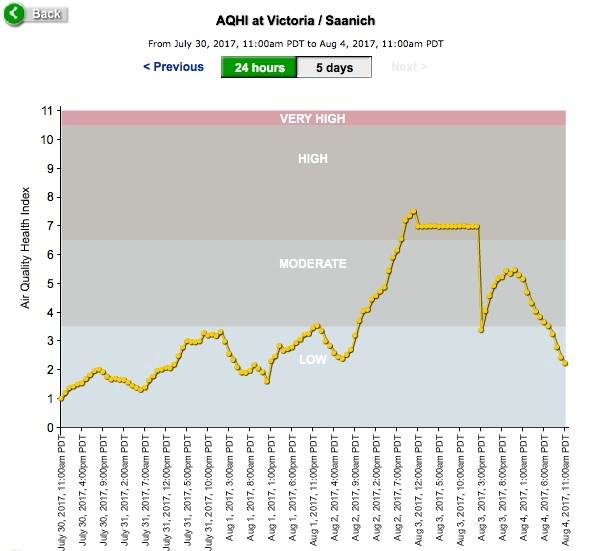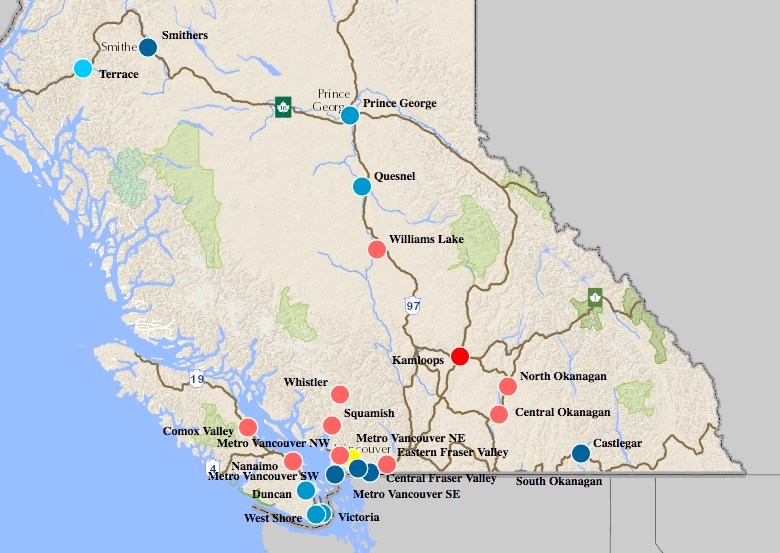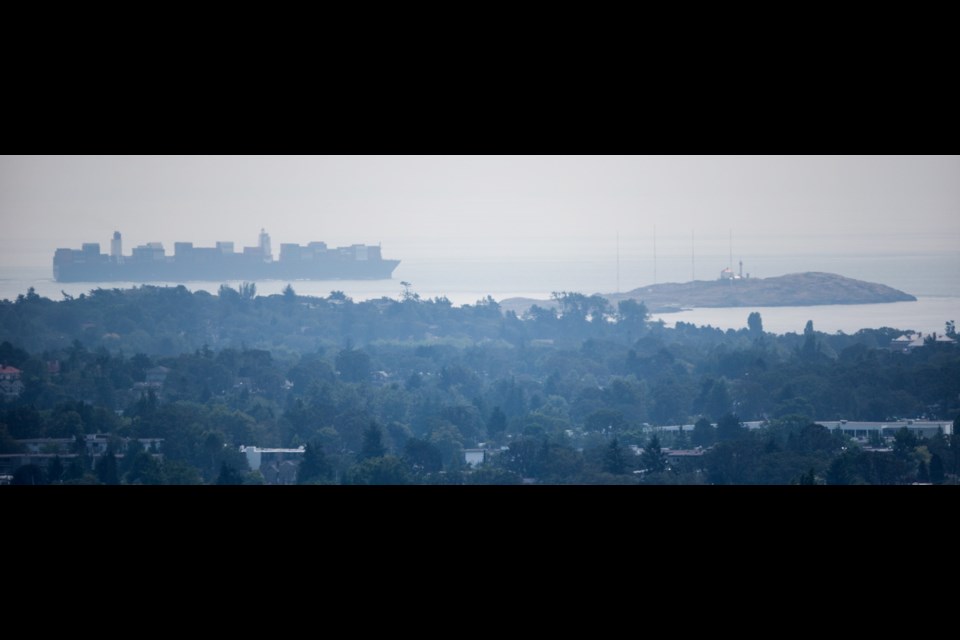Update
The area covered by a Smoky Skies Bulletin was expanded to cover East Vancouver Island, Inland Vancouver Island, West Vancouver Island, North Vancouver Island, Southern Gulf Islands and Greater Victoria.
Here's an animation of the smoke forecast (it covers Friday morning to Sunday morning) from FireSmoke.ca.
This chart from the B.C. government [link] shows how the Victoria/Saanich air quality health index ratings changed over July 30-Aug. 4, 2017:

You can see an interactive map showing air quality around the province here [link] (the version below is just a snapshot from Thursday morning). As of 11 a.m. Sunday, the rating for Victoria/Saanich was 2 (low health risk), the West Shore was 2 (low), Nanaimo/Parksville was 7 (high), the Comox Valley was 7 (high), and Duncan was 3 (low). For comparison, the rating in the Kamloops was 7 — it reached 49 on Thursday — and Whistler was 8. Anything above 10 is considered a very high health risk. You can see a table of the most recent ratings here [link].

Red dots on the map indicate a high health risk: People with heart or breathing problems are advised to reduce or reschedule strenuous activities outdoors. Children and the elderly should also take it easy. The general population should consider reducing or rescheduling strenuous activities outdoors if you experience symptoms such as coughing and throat irritation. Full story [link]
This is what the smoke looks like from above:
Here's a 3 day loop (Mon-Wed) of NASA Terra satellite images showing the dramatic spread of wildfire smoke into Western Washington. #wawx pic.twitter.com/8YeITEH69U
— NWS Seattle (@NWSSeattle) August 3, 2017
—
Original story
The effects of smoke from Interior wildfires have been getting worse on the south Island, says Island Health’s medical health officer.
Local air-quality stations are picking up what is happening, Dr. Murray Fyfe said Thursday.
The stations are at Topaz Park in Victoria and in Colwood, Fyfe said. “Both of them have shown over the last 24 hours substantial increases in particulate matter — fine particulate matter.”
Levels of particulates have been exceeding provincial air-quality standards, he said. “So that’s a health concern for people, especially those with underlying heart or respiratory conditions.”
Increased air pollution can also be a concern for children and seniors.
A smoky-skies bulletin from Environment Canada is being continued, and residents in communities in east Vancouver Island, the southern Gulf Islands and Greater Victoria have been asked to exercise caution when spending time outside.
Record heat is also forecast for the south coast. Temperatures in the mid-30s are expected, prompting an Environment Canada heat-wave warning.
Several record temperatures were set this week. Campbell River hit 33 C on Tuesday, besting its previous high of 32 C for that day in 1965. Tofino (28 C) and the Victoria Harbour (25.9 C) also set new marks for Aug. 1.
On Wednesday, Tofino smashed its previous Aug. 2 high (27.2 C) with a temperature of 31.5 C. The Malahat area (32.5 C), Port Alberni (36.8 C), Port Hardy (23.1 C), and Estevan Point on the west coast of Vancouver Island (21.9 C) also broke records.
With no precipitation in the forecast, the Victoria area is moving toward an all-time record for dry weather, based on Victoria International Airport measurements.
There was no rain recorded in July at the airport, a common site for compiling weather figures. At the Gonzales station, 0.8 millimetres was recorded on July 22.
Rainless Julys were also seen in 2013, 1958 and 1941, said Environment Canada meteorologist Alyssa Charbonneau.
She said the last measurable rain at the airport came on June 20, putting the total of consecutive dry days through Wednesday at 43.
“The longest stretch ever recorded was 53 days; that was in 1986 from July 18 through Sept. 8,” Charbonneau said. “Second place is 45 days in 1991 from Sept. 1 through Oct. 15.”
The record is well within reach, she said. “The way the forecast looks right now, there’s definitely potential there that we could break the most days without rain or measurable precipitation,” Charbonneau said. “We’ll have to wait and see.”
She said there is a set mark for what constitutes an official rainfall. “A few raindrops wouldn’t be enough. We need to get more than 0.2 mm of rain recorded.”
While there has been some rain on the Island in the past month or so, dry weather has dominated, she said.
“Basically, the farther north you go, the more rain there’s been,” Charbonneau said.
“Port Hardy, for example, recorded 20.2 mm of rain in July, but it’s been nearly dry since July 22.”
Comox and Port Alberni are following a similar pattern — some rainfall in July, but none since July 21 or 22.
Real-time air-quality information for Vancouver Island and the southern Gulf Islands is available at www2.gov.bc.ca/gov/content/environment/air-land-water/air.
Advice to minimize health effects of smoky skies
• If you have a chronic condition, have rescue medication on hand at all times and a plan to follow if your rescue medication cannot bring your condition under control.
• Look for indoor environments that might be less smoky, such as shopping malls, community centres and libraries.
• Avoid physical exertion because the amount of smoke you breathe increases as your breathing rate increases.
• Keep hydrated as it helps your body deal with inflammation.
Source: Government of B.C.
Keeping cool on the job
Record-breaking summer temperatures can put workers at risk of heat stress, and employers have a duty to keep worksites cool enough for safety, says WorkSafe B.C.
“By law, employers are required to know if their workers are at risk by performing a heat-stress assessment and implementing a mitigation plan, when necessary,” Dan Strand, prevention field services director, said in a statement.
Symptoms of heat exhaustion include excess sweating, dizziness, fainting and muscle cramps. In heat stroke, sweating stops, but breathing rate increases. Confusion, seizures and even cardiac arrest can occur.
Employers are reminded to monitor heat conditions, ensure adequate first-aid coverage and emergency procedures if needed, modify facilities, equipment and processes to reduce exposure to heat and change practices and policies to limit risk, WorkSafe B.C. said.
“Determine appropriate work-rest cycles; when a worker feels ill, it may be too late.”
Work activities should be rotated or supplemented with additional staff to reduce exposure to heat. Cooling areas with shade and water are required.
In 2016, WorkSafe B.C. accepted 16 claims for injuries due to heat exhaustion and heat stroke on the job, with claimants led by truck and bus drivers, lifeguards, recreation, sports and fitness leaders and film-production assistants.
Tell us about your hottest summer job — whether it’s hot-tar roofing or working in a bakery. Send your story to [email protected] and put “hot job” in the subject line.
— Katherine Dedyna



